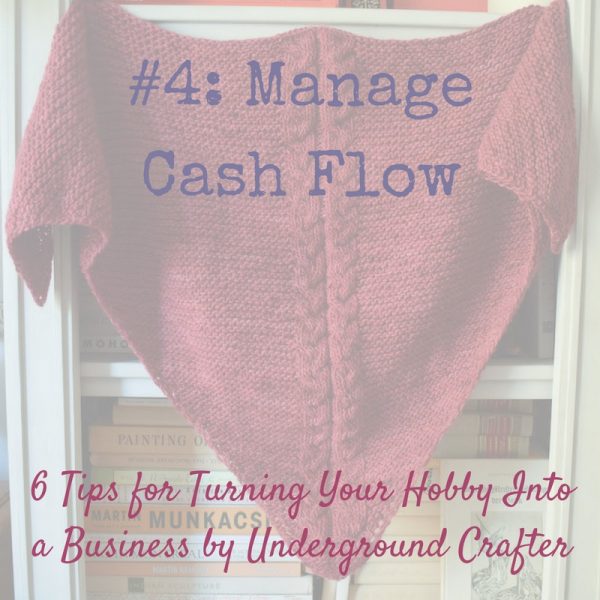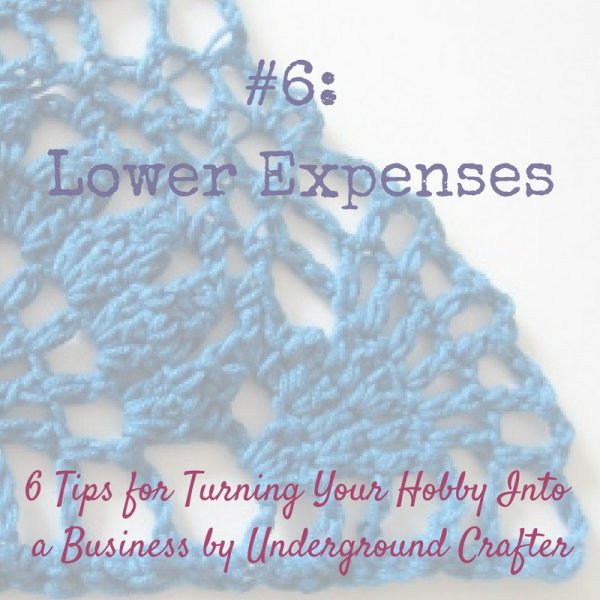 Nine years ago, I turned my passion for crafts into Underground Crafter. Over the years (and especially since I launched the Creative Yarn Entrepreneur Show podcast in 2014), I’ve had many crocheters, knitters, and other crafters reach out to me and ask how to turn a hobby into a business.
Nine years ago, I turned my passion for crafts into Underground Crafter. Over the years (and especially since I launched the Creative Yarn Entrepreneur Show podcast in 2014), I’ve had many crocheters, knitters, and other crafters reach out to me and ask how to turn a hobby into a business.
This post is sponsored by Intuit QuickBooks and #WeAllGrow Latina Network, but the opinions and thoughts are my own.
In this post, I’m going to share six tips to help you get started as you make the shift from hobby to business, along with helpful (and free!) resources from the Intuit QuickBooks Resource Center.
1) Understand Why YOU Want to Own a Business
 Knowing what your purpose is in making the transition from hobbyist to business owner will provide you with direction and motivation. Some crafters want to earn just enough money to fund their own craft supplies, others are looking for a steady side income that will pay for extras like vacations, and a few are planning to eventually replace their income from work. Once you’ve determined what your purpose is in starting a business, you can use this guide to choosing your business structure to help you identify the right legal structure.
Knowing what your purpose is in making the transition from hobbyist to business owner will provide you with direction and motivation. Some crafters want to earn just enough money to fund their own craft supplies, others are looking for a steady side income that will pay for extras like vacations, and a few are planning to eventually replace their income from work. Once you’ve determined what your purpose is in starting a business, you can use this guide to choosing your business structure to help you identify the right legal structure.
By the way, both your purpose and your legal structure can change over time. When I started Underground Crafter, I was really just looking for a way to fund my craft hobbies. Now, it’s an important part of my household income.
2) Shift Your Mindset
 You may have noticed that I wrote “own” a business and not “have” a business. It seems like a minor point, but changing your mindset from a hobby crafter to a business owner is just as important as understanding the purpose of your business. Your plan is now to own a business that will eventually be profitable (meaning that your business will earn more than the resources that are put into it).
You may have noticed that I wrote “own” a business and not “have” a business. It seems like a minor point, but changing your mindset from a hobby crafter to a business owner is just as important as understanding the purpose of your business. Your plan is now to own a business that will eventually be profitable (meaning that your business will earn more than the resources that are put into it).
This mindset will help you to make decisions and to develop the confidence to work with other partners, such as sponsors. It may also help you set boundaries at home. Let’s face it: Your partner, children, or family may be confused about the shift in focus of your crafting. They may not think of you as being “at work” while you’re sitting on the couch knitting. The more you can adapt a business owner’s mindset, the more you can help those around you understand and support your goals.
3) Develop a Plan
 It’s been my experience that craft businesses with concrete goals are more successful and longstanding than the ones where the owners always fly by the seat of their pants. Now, since most hobby businesses (at least at the beginning) are not very resource-intensive, many owners avoid developing a business plan. Once you read the 7 Elements of A Business Plan, you’ll realize that business plans aren’t just for companies seeking loans or investors; business plans also help you to keep your business organized, remind you to plan ahead, and clarify goals when difficult decisions need to be made.
It’s been my experience that craft businesses with concrete goals are more successful and longstanding than the ones where the owners always fly by the seat of their pants. Now, since most hobby businesses (at least at the beginning) are not very resource-intensive, many owners avoid developing a business plan. Once you read the 7 Elements of A Business Plan, you’ll realize that business plans aren’t just for companies seeking loans or investors; business plans also help you to keep your business organized, remind you to plan ahead, and clarify goals when difficult decisions need to be made.
4) Manage Cash Flow
 Earlier this year, I attended a workshop sponsored by Intuit QuickBooks Self-Employment at Etsy’s headquarters in Brooklyn. One of the tax pro speakers made a statement that really stuck with me. She said, “books are to help you run your business, not for the IRS.” So many small businesses avoid bookkeeping because they associate it with “tax time.” In reality, if you’re not tracking your expenses and the money coming in to your business throughout the year, you have no idea what’s happening in your business.
Earlier this year, I attended a workshop sponsored by Intuit QuickBooks Self-Employment at Etsy’s headquarters in Brooklyn. One of the tax pro speakers made a statement that really stuck with me. She said, “books are to help you run your business, not for the IRS.” So many small businesses avoid bookkeeping because they associate it with “tax time.” In reality, if you’re not tracking your expenses and the money coming in to your business throughout the year, you have no idea what’s happening in your business.
Before you can manage your cash flow, you have to know what it is. The Beginner’s Guide to Cash Flow gives a great overview and explains the difference between profit and cash flow.
Most crafters struggle with the administrative aspects of their businesses. Let’s face it: We’re creative types and we want to spend more time crocheting and less time doing data entry or sending out invoices. The QuickBooks Resource Center has some great forms you can adapt so you don’t have to spend much time setting up your systems, such as this free Cash Flow Statement template with a guide and example.
5) Diversify Income Sources
 Another way to enhance cash flow throughout the year is to make money from several different sources. This is especially true because many crafts are seasonal and you might not bring in much cash during certain times of the year.
Another way to enhance cash flow throughout the year is to make money from several different sources. This is especially true because many crafts are seasonal and you might not bring in much cash during certain times of the year.
In my businesses, I maintain websites that are monetized through ad networks and affiliate links; write patterns, articles, and tutorials for third-party publishers as a freelancer; teach crochet and knitting; sell my independently published patterns and books; provide tech editing services to other designers; and work with sponsors. I’ve also sold hooks and kits and provided services to yarn companies in the past. You can find out more about different income streams by reading (or listening to) 6 Income Streams for Yarn-Related Businesses.
6) Lower Expenses
 If you’re like most craft-related businesses, it will take you some time to become profitable. Until you’re earning as much as you’d like, minimize the impact of your business on the rest of your household by lowering expenses. Not surprisingly, this helps with cash flow, too. Here are a few ways to get started.
If you’re like most craft-related businesses, it will take you some time to become profitable. Until you’re earning as much as you’d like, minimize the impact of your business on the rest of your household by lowering expenses. Not surprisingly, this helps with cash flow, too. Here are a few ways to get started.
- Read (or listen to) my 4 suggestions for sourcing yarn inexpensively for your business.
- Take a DIY approach to running your business initially. It can be fun to shop for new gadgets and promotional items for your new business. Instead, save money by making something, buying used, or upcycling until your business is bringing in more money. If you don’t need it, wait until your business can afford it.
- Make the most of free trials. If a service or software offers a free trial, actually use it! Make sure during those 7, 15, or 30 days that it is an expense that your business really needs to take on at this moment. This is also a great way to find out if it is a service or product you are comfortable using and whether it is worth the expense.
- Use the QuickBooks Resource Center to educate yourself. You’re probably already familiar with Intuit because of QuickBooks, the top accounting software for small businesses, or TurboTax, my preferred software for tax preparation for the past 8 years. Through QuickBooks, Intuit has been helping millions of small businesses to manage their finances for over 30 years. They offer the QuickBooks Resource Center for free, and it’s great to have access to so many articles and forms from a trusted source. Some that might be particularly helpful to new craft businesses are…
- A self-employment tax calculator that helps you figure out how much to pay for your quarterly self-employment taxes.
- The inventory management section may help makers who sell handmade products or those who retail hooks, needles, or other craft supplies, to get organized.
- And, finally, when you do need to spend some money, be sure you keep in mind the 10 Tax Deductions Every Freelancer Needs to Know.
I hope you’ve found these six tips for shifting from a hobbyist to a business owner helpful. If you decide that owning a crafts business is a journey you’d like to take, I wish you success! (And, if you’d rather stick with crafting for fun, that works for me, too!)
This is a sponsored conversation written by me on behalf of Intuit QuickBooks and #WeAllGrow Latina Network. The opinions and text are all mine.


1 thought on “6 Tips for Turning Your Hobby Into a Business”